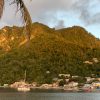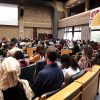Monday, May 13, 2024
News and Views from the Global South
ENVIRONMENT-ICELAND: Hay Restores Eroded Land
Lowana Veal
- Icelandic farmers have found a successful way of repairing erosion escarpments: they blow cut-up hay at them.
The practice of using hay to counter escarpments originated when farmers wanted to get rid of unusable hay bales. Icelandic hay bales are wrapped in plastic, and at that time birds were attracted to one of the chemicals used in the plastic. They pecked at it, creating holes, which meant that the hay became damp and could not be used.
So, something had to be done with the unusable hay. The farmers took it up to the highland pastures, chopped it up and put it at the foot of erosion escarpments. When the wind blew, soil formed around the erosion patches, thus allowing vegetation to take root. The hay turns into soil with time – the fibres in the hay become building material for the soil.
Sheep farmer Gunnar M. Thorisson says that the practice was widely known to have begun about 15 years ago, although he remembers something similar long before that, around 1970.
Agricultural plastic is no longer sought after by birds. However, farmers found that the hay technique was so effective that they now set aside hay bales specifically for repairing erosion escarpments.
Regional re-vegetation associations have bought special hay shredders to blow hay at the erosion escarpments. The shredders make the process more efficient than before. They can direct the hay higher up escarpments, up to 30 metres, and thus deal with difficult erosion patches that could not be restored using the old method.
About 15 kilometres of erosion escarpments have been treated using a hay shredder in South Iceland alone. Re-vegetation associations have received sizeable grants for the project because the technique is so promising. The Biskupstunga Re-vegetation Association (BRA) in South Iceland received about 88,000 euro this year from a fund created by the sale of plastic shopping bags in Iceland.
The Biskupsstunga association, which is made up of farmers, was the first to buy one of the shredding machines.
Margeir Ingolfsson, who is on the management committee of the BRA, told IPS: “The best results are obtained if small quantities of fertiliser and seeds are blown at the erosion escarpments, and also if hay is blown at ground level around the eroded area. If this is done, the damage is repaired more quickly than otherwise as it creates a framework for soil formation, hastens the re-vegetation process and stops further erosion from happening.”
When asked if the practice was peculiar to Iceland, Ingolfsson said: “It was not modelled on something done elsewhere, but I’m not totally sure if the practice is restricted to Iceland.”
Andres Arnalds, assistant director of Iceland’s Soil Conservation Service told IPS: “The farmers are doing great things, both by spreading hay on gravel and other barren areas, and by directing it at erosion escarpments, which become restored to a greater extent than otherwise.”
“There are a number of reasons for erosion and desertification in Iceland,” says Arnalds. “When Iceland was settled in 874 AD, it is estimated that up to two-thirds of Iceland’s total land area of 103,000 square kilometres was covered by vegetation, of which at least 25 percent was made up of trees and shrubs.”
“But almost immediately the vegetation cover started to erode, because of forest destruction and collection of wood for fuel. Grazing pressure by sheep hindered regeneration, and a cooling climate resulted in the vegetation becoming more delicate than before. Icelandic soil is highly susceptible to drift if the vegetation cover is disturbed.”
Erosion is greatest in volcanic areas where the soil is drier, he said. “It was only after the trees had been cut down that volcanic eruptions started to have such an effect. Instead of being trapped by shrubs, volcanic ash drifted over the land.”
Various methods have been tried in Iceland to stop erosion and restore the damaged land. According to Arnalds, the native lyme grass has been very successful in stopping further erosion and in stabilising sand. It is a pioneer plant, and disappears when other plants can start growing in the area.
Re-vegetation follows, initially using seeds and fertiliser to encourage the vegetation that has come up. The Soil Conservation Service also operates a project in collaboration with farmers in which farmers are provided with seeds, fertiliser and advice on how to restore their own land.
The leguminous, blue-flowered Nootka lupin plant from Alaska has also been used to stop erosion. “Re-vegetation using lupins is a method that is virtually restricted to Iceland,” says Árnalds. “In most cases it’s a pioneer that disappears after a few decades, but in some places there is a danger of it becoming permanent – which mustn’t happen as lupin is an alien species and could thus spread more than is desirable.”
Because Iceland has so much experience in dealing with restoring land, many scientists have visited the island to learn more. “A seven-week course in the subject has just been completed, in which students from Uganda, Tunisia, Mongolia and Egypt have been learning about land management and land restoration, culminating in a small project that will be of use to them in their home country,” Prof. Ingibjorg Svala Jonsdottir from the Agricultural University of Iceland told IPS.
“But this was a pilot project, as in future this course will be extended to six months and come under the auspices of the United Nations University,” she added. The course will be called the Land Restoration Training Programme, and will be hosted by both the Agricultural University in Hvanneyri, West Iceland, and the Soil Conservation Service at Gunnarsholt in the south.
Desertification and soil erosion are regarded as major environmental problems in Iceland.

 Print
Print




